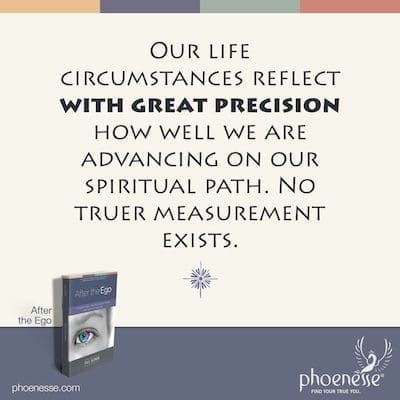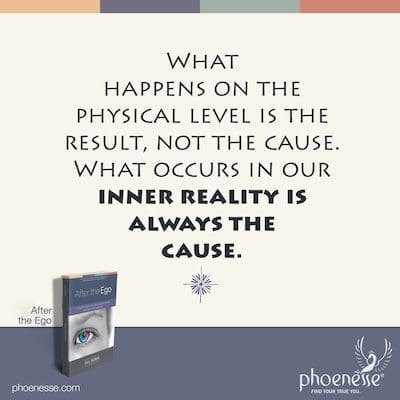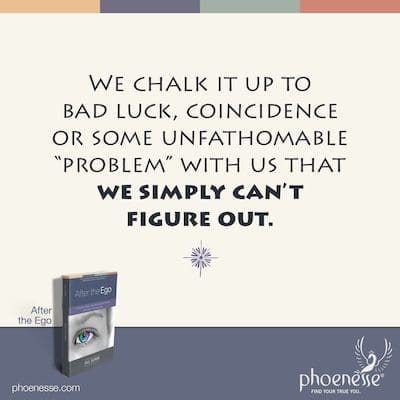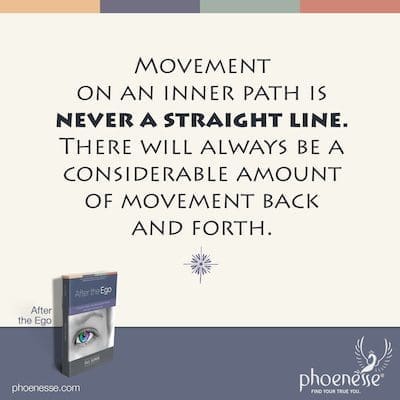Doing the hard work of deep personal self-development requires equal measures of courage and commitment, honesty and humility. The rewards we will receive—in proportion to our investment—are peace and fulfillment. This is cause and effect. Our problems will begin to unravel, which we may have long doubted in our hearts was even possible. We will start to form closer relationships that are more authentic.
Intimate friends are people with whom we experience peace, light, hope, fulfillment and trusting closeness. The presence of such friends, or the lack, thereof is a good gauge telling us whether something is amiss within. For this gauge is so exact! Our life circumstances reflect with great precision how well we are advancing on our spiritual path. No truer measurement exists.

We can never measure ourselves against anyone else. Wherever we are right now, might be just right for us. It may be the exact place we need to be. Knowing this can brighten our perspective and provide us with a shot of hope. Someone else, on the other hand, might find themselves at an identical inner crossroads. And yet that person may be lagging behind on their personal path.
It’s entirely possible this other person won’t accomplish the plan they had hoped to fulfill during this particular incarnation. That person, then, will be in strife—with others and/or themselves. The only reliable gauge for how we are doing on the plan for our lives is this: How do I feel about myself, my relationships and how my life is going?
Now let’s turn our attention to how we should proceed once we’ve uncovered an intention to remain mired in negativity. We will need to keep exploring our negative intentionality, owning up to it in a spirit of honesty and openness. Then what comes next—after we are truly ready to let it go—will be to exchange it for positive intentionality.
The key is that we must have a complete understanding of what commitment means, on the one hand, and cause and effect on the other. At first glance, these two things may appear to be unrelated to our negative intentionality. But they are all intrinsically linked, and we’re about to learn why.

The cause: Commitment
We’ll look at commitment first, starting with what it means to commit. We tend to throw this word around like we already know what it means. But often, we don’t have a true understanding. Above all, it means having single-pointed attention, giving ourselves wholeheartedly to whatever we are committing to. When we are committed, we give our best to whatever we’re doing. We allow ourselves to focus on all aspects of the subject in front of us.
Commitment means we don’t shy away from giving our all. We give all of our energy and all our attention. And we use our finest thinking faculties as well as intuition, which we can open up to in meditation. The whole effort consists of using the following: physical energy, mental capacity, feelings and will. With each of these at our disposal, we will be able to activate dormant spiritual powers. Then we can use them in service of any constructive new venture.
Such a holistic approach can only come about when we have full use of a will that’s not broken apart by negative counterforces. In other words, if we want to fully commit, we cannot have any negative intentionality.
Commitment is an aspect of anything we can imagine doing. It doesn’t only apply to grand and significant undertakings, such as our spiritual path of self-evolution, which is the most important venture we can embark on in life. All the little mundane tasks of life also require commitment. To the degree we commit to something, to that degree it will give us pleasure and be free from conflict. It will be rewarding and focused in scope, and it will have meaning and depth. It will succeed, and it will feel blessed.
Any time we give an undertaking our all—and not a drop less—it can only be satisfying and rewarding. But how often is this actually the case? It’s relatively rare, indeed. Usually we give half an effort and call it good. Then we are confused and disappointed when we don’t get the results we were hoping for.
This is where cause and effect comes into the equation. When we don’t realize that the effect is the result of a cause we set into motion with our half-hearted commitment, a split happens in our consciousness. And this split sets numerous negative chain reactions rolling. In our confusion, we feel helpless and steeped in a sense of injustice. Further, we are not even aware that we commit only part of ourselves while another part still says No. And since we disregard that this has anything to do with the outcome, we can’t help but feel bitter.
The world, we believe, is a haphazard place, and there’s no rhyme or reason to anything. This frightens us, causing us to become defensive and ruthless, distrusting, grabbing and anxious. Instead of working to fix the true problem—the negative counterforce that cripples our full commitment—we apply our life force to pushing others away, withdrawing into failure and giving up on making an effort.
When we can’t find the link between cause and effect—in this case, between our lack of commitment and the frustration that results—we seek to make an adjustment, but go about it in the wrong way. The real culprit, whenever there is flagging commitment, is our negative intention.

Looking for trouble
To find our negative intention, we must find the inner voice that says something like, “I don’t want to give the best of my efforts, my attention, my feelings, my honesty, my anything. Whatever I do, it will be because I have to. Or because of an ulterior motive like wanting to get a certain result without having to pay the price”. It is monumentally important to be able to have an awareness of an inner attitude like this. It is the key to understanding other connections that we also cannot dispense with along our path.
Just having the awareness is not enough, by itself. We have to establish the link between cause and effect. For it’s entirely possible to become aware of our negative intentionality, yet fail to establish this link. In our work on our spiritual path, we must search for where we deliberately hold back with a spiteful attitude, at least to a certain extent. We must become aware of this fundamental truth: If there is some aspect of our lives we deplore and that causes us serious suffering, this is direct effect of causes we ourselves have set into motion with our negative intentionality.
Most often, though, we blame other people and their wrongdoings for our suffering. Or we chalk it up to bad luck, coincidence or some unfathomable “problem” with us that we simply can’t figure out.
So here is the most important point of all this: We need to explore whatever makes us most unhappy in life. What do we suffer from? Is it something overt, like a problem with our partner, or maybe the lack of the proper partner? If so, we can ask ourselves: What is my intention here? Then, when we can find the voice saying, “No, I don’t want to give love or this relationship my best,” we will see the link to our suffering. Then we will have hooked up cause with effect.
If our problem is financial security, we can cast around inside until we find the negative intent that says, “I don’t want to be able to take care of myself. Because if I do that, I will be letting my parents off the hook. Or I might be expected to give something I simply don’t want to give”. It’s critical we see how our negative intent brings the result. And be aware, this happens regardless of how sneaky and subtle it is. Often, we’ll find it hiding underneath a tense striving for some kind of fulfillment.
We can easily deceive ourselves with such overactivity, thinking this should do the trick to bring about the positive result we want. All the while, we continue to ignore the power of the hidden negative cause. And that is sure to extract an effect. Even after we become aware of our negative intention, it’s entirely possible to discount how important it is. But if we’re not even aware of it, now is as good a time as any to begin the excavation process. We must peel back the layers of the inner regions of our mind. And we must search for clues about what’s leading to the undesirable effect.
Where do we feel frightened or insecure? Where do we feel inadequate? Do we notice a tension or anxiety we can’t explain? Or do we feel guilty but don’t know why, so we try to talk ourselves out of it since it seems so unjustified? Do we hate our weaknesses, or our lack of self-assertion? Friends, all these are effects of some negative intention that, on a certain level, is deliberate. We must find it and bring it out into the open.
For example, let’s say we harbor a negative trait—something like spite, malice, rebelliousness, stubbornness, hate, pride—and it makes us feel guilty. Such guilt may find an outlet in guilt that is artificial and unjustified. After all, guilt is not a positive trait so it must lead to self-destructive acts. There’s a good chance it can cause all the ills we’d like to be free from, like anxiety or lack of assertiveness. But the only way to be genuinely free from these things is if we make the connection between them and what’s causing them—the negative intention. Then we can give up the negative intention.
If we don’t become aware of this connection, we will feel like a persecuted victim. The more we’re inclined to not admit to our negative intention, the more we’ll try to capitalize on that position, hoping to “convince” life, fate and other people to give us what we want. We will lean all our weight on blaming self-pity, resentments and helplessness to get what can only come through a positive intention.
Positive intention requires a lot of commitment—totally and unequivocally. If we are not willing to invest ourselves like that, then we are wanting to use illegitimate means to get the results we want. This, of course, fires up guilt. And guilt ramps up our fear of meeting ourselves in honesty. Hence, we convince ourselves all the more that the trouble must be an outside factor. Or maybe, just maybe, it’s something harmless within us. And so we go through life, with a vicious circle well underway.
Making the mature connection
Some people, after making some good headway on their spiritual path, get a glimpse of their negative intentionality. This is truly nice progress. But then we tend to forget it. We disregard that it is really having an effect. We fail to connect the dots. Then off we go on our merry way.
Others of us admit that we have a desire to hang onto our destructiveness. We like our hateful, vengeful, vindictive selves, for example. And yet we miss the connection between our intent and our misery. But how could this not bring unwelcome effects from others? No matter how good we think we are at hiding our negative intention, and no matter how strongly we express our positive attitudes—which are also present—the negative component will color our actions and behaviors more than we realize. Plus, quite apart from that, our negative intent will invariably affect other people’s soul substance, triggering unconscious reactions.
For the average person, a lot of perception is happening on the unconscious level, so we are ping ponging unconscious interactions with others under the table, all the time. While our conscious interactions may be civil enough, it’s the unconscious one filled with rifts and troubles that both parties find mysterious. In our confusion, we respond with self-blame and deadness of feelings, which call forth the negativities in the other that they have not yet explored.
This is how negative interactions go, on and on and on. The only way to break the cycle is for a spiritually mature person to surface their unconscious perceptions of negative intent. And what a blessing this is. Such a person will be able to avoid the deadly confusion that otherwise arises, and to deal with the situation.
Seeing the relationship between cause and effect in our lives will motivate us to give up our negative attitudes and cultivate positive ones. This is how we gain spiritual and emotional maturity. After all, what is maturity but the ability, to a large extent, to put together cause and effect. Such an ability reflects a significant amount of awareness, typically gained by doing personal self-development work.
Consider an infant. When an infant hurts physically, it has no ability to connect cause and effect. An infant simply doesn’t have the mental faculties yet to do this. Whatever is causing the pain is totally blotted from its conscious mind. The infant merely experiences the effect, which is the pain.
After the infant grows a bit and becomes a young child, it can start to infer cause and effect when they happen close together. So let’s say a small child touches fire and gets burned. It will understand that fire is the cause and that the burning sensation is the effect. In this way, it learns a life lesson: to avoid the burning sensation, it must avoid touching fire. In this example, cause and effect are very close together in time. With this lesson, the child has obtained its first degree of maturity on the road of human development.
But this same child cannot yet correlate the relationship between cause and effect when there is a distance between the two things. A little further down the road, however, when the child is a little older, it will be able to realize that, say, a tummy-ache is connected with overeating a few hours earlier. So now a further degree of maturity has been reached.
The more mature we become, the greater will be our ability to connect cause and effect when the link is less obvious and occurs over a longer range of time. But if we remain emotionally and spiritually immature, we won’t have sufficient awareness to trace cause and effect realistically. Such people can’t see how their experiences—along with their state of mind—are directly linked to a certain set of causes.
They can’t see that their past actions have brought effects, or that underhanded, inner attitudes will not go unnoticed. They may search high and low for the cause, hoping to find answers, and may even turn to look inside themselves. But if they can’t close the gap between cause and effect, they’ll go around and around in circles, instead of moving along a spiral, which is the true movement of a spiritual path.
Cause and effect over lifetimes
From our human perspective, it does not appear that the relationship between cause and effect remains intact from one lifetime to the next. Only as we increase our level of awareness—by doing the healing work as outlined here—does a person mature enough, spiritually, to realize that causes from former lives are having effects here and now. At first we may sense this, and later, we will inwardly know that this so.
A deeply meaningful, inner knowing that explains key points about our life is a revelation we must earn through our personal work of self-healing. This is not the same as receiving a piece of information from a psychic regarding previous incarnations. Inner knowledge is something that comes about organically.
A psychic or clairvoyant person’s ability to predict the future relies on their ability to perceive causes within someone’s soul. And the lawful effects of those causes cannot fail to materialize. Many people do not understand what is really happening here, and so end up believing that some mysterious or supernatural thing is manifesting. Many wrong philosophies then spring from this misconception. One such off-base theory is the idea that our fates are predetermined.
Doing the work of self-healing is a maturing process that allows us to increasingly link up cause and effect. The growth in our awareness that’s involved in this process ushers in so much peace and light! At first we might find it very uncomfortable to see how we are the ones who have created what we deplore. It can be hard to see that if we wish to have different experiences in life, we’ll have to give up what we are fiercely hanging on to.
But once we perceive the beauty of these laws and accept them, a sense of safety and freedom will arise in us that is indescribable. The knowledge will convey to us, like nothing else ever could, just how safe, loving and just this universe is.
We will see things that seem like a fate beyond anyone’s control—where we are born, as which sex, how we look, what our talents are—for what they are: self-caused and self-wanted, sometimes wisely and sometimes destructively. For everything is established based on cause and effect relationships that carry from one lifetime to the next.
This is the mechanism determining what seems to be our current fate, in this lifetime. For we each have both positive intentionality and negative intentionality in us. And each of these things creates entirely unique experiences and states of mind. Why would this principle change when an entity transitions from one body to another? There is nothing at all wrong with this principle. No exceptions, interruptions or changes are needed.

The stages of a spiritual path
Purification
This path, and others like it, can be broken down into the following stages. First we struggle mightily to excavate deep inner layers. These layers are filled with 1) misconceptions, 2) negative intentionality and 3) residual pain. The approach varies somewhat for each person, but eventually, we must explore one and then another of these aspects.
Movement on an inner path is never a straight line. There will always be a considerable amount of movement back and forth. As we go along, we will explore more aspects, but the work of purification primarily focuses on these three areas: When we are 1) able to exchange deep misconceptions for the truth, and when we 2) are able to convert our negative intentionality into positive intentionality, and when 3) we no longer defend ourselves against the experience of pain, then a substantial step will have been made. The bulk of our initial purification will be complete.
What, essentially, is negative intentionality? It is a defense against experiencing pain. And misconceptions? They are a result of both our defending and our reacting to pain. So these three aspects are integrally connected. It is a sign of maturity to be able to experience what we ourselves have produced, and not fight it. A soul that is mature makes itself light, receiving its own innate feelings and savoring them fully. This is the only way to erase evil from this world. For all our defenses harbor evil, which is not hard to spot in any form of negativity. Evil then is born from our misconceptions.
On this evolutionary road we are on, it is the task of each human being to eliminate evil by changing it back into its original state of truthful, loving consciousness and pure, clean energy. It takes many lifetimes to get through this phase of the work—the purification phase.
Evil produces pain. Our fear of this pain and the defenses we build against pain produce more pain—which is actually a worse pain—as well as more evil. So our defenses are nothing but illusions that don’t work. We can experience the truth of this the moment we fully open ourselves to the experience of pain. Note, we’re not speaking here about false pain. That’s the pain that is itself a defense. It’s a twisted, unbearable, bitter pain that is derived from a forcing current that says, “Life, don’t do this to me!”
This kind of pain lacks the mature willingness to let go and just let the real pain be what it is. When we experience real pain, we stop trying to control it, manipulate it or hide it. The pain simply is. In this way, we approach the state of being, with all its associated peace and bliss. We will be able to taste this more and more as we shed all our defenses, which will free us up to adopt a positive intention to give our best in life.
The false form of pain, which is still a defense, is filled with bitterness, self-pity and resentments. As such, it is a peace-destroyer. Real pain, on the other hand, is peaceful because we assume complete self-responsibility—without self-manipulation. We’re not saying, “Poor me, this is what life is doing to me,” nor are we saying, “I am so bad and hopeless that I can never be free.” Neither of these attitudes is in truth, which makes them part and parcel of evil.
To experience real, undefended pain is to open the door to our soul and let in light. This is the way to expose the core of ourselves, with its vast stores of creativity, resiliency, and deep feeling and knowing. When we have learned to make ourselves available for whatever life offers—even if life occasionally offers us pain—we don’t need to resort to negative intentionality.
After we have worked off our residual pain, should a new, current pain come along, we’ll be able to experience it for what it is. We won’t need to deny it or exaggerate it, and we won’t need to layer on a bunch of artificial interpretations about what happened. And on that day, no misconceptions, no negative intentionality, no evil and no suffering can exist.
This is the state that brings an end to fear: no more fear of death, fear of life, fear of being, fear of feeling, or fear of loving. And don’t forget, fear of experiencing the grand heights of universal life is the greatest fear in the world.
Transcendence through Transformation
To whatever degree evil exists—which we have just identified as our misconceptions, defenses, negative intentionality and refusal to experience the pain we ourselves have caused—bliss will be unbearable. So in the second major phase on a spiritual path, our soul must acclimatize itself to universal bliss. But we will need to evolve to this gradually. For even though our soul is now largely free from evil, we will need to develop the strength to withstand the enormous power that emanates from the Real Self.
The blissful, pure energy of the spirit is so strong that only the strongest and purest individuals can live comfortably in it. We’ll taste the truth of this to some extent as we purify ourselves spiritually, only to discover how hard it is to be with pleasure, ecstasy and happiness. We feel more comfortable in the greyness we’ve gotten accustomed to.
The power of the universal spirit is not compatible with the slow moving energy of unexperienced pain, defenses and evil. This explains why people who were present during the transmission of these teachings would break into tears in response to the pure influx of spiritual power. The grip of strong feelings would cause people to cry, as it elicited old residual feelings of sadness, longing and pain. For whatever has not been experienced always slumbers within.
But even as people were experiencing the welling up of difficult feelings, they could also feel the spiritual nourishment, joyfulness and freedom that accompanied the love pouring forth. As we go forward, more joy will manifest, as it bubbles up from within. For it is our tears that open the channels of joy.
When we stay tightly defended, we make ourselves hard and “safe.” Our willingness to expose the temporary truth of the evil that lives in us will give us the strength we need to let go, so that we can be able to feel and become more real. By no means does it serve us to justify our defensive hardness by doubting and judging. This, ultimately, is the way we defend ourselves against the truth of who we are. What folly! For we deal ourselves out of life and then complain bitterly about it.
When we are ready to commit, 100%, to feeling whatever is in us, then we can become free. Then we can wake up. As we let go of our defenses, then we can transition from bitter, hard false pain to the real pain that is soft, melting and joyous—yes, joyous. For real pain carries the germ of life embedded in it. This seed will soon take root in our consciousness and bloom, as we commit to our feelings and to experiencing life—with no holding back.
A joyful life is possible, if we will only give up our stubbornness; our ties with others can be enriching and warm. Each of us has taken on a great responsibility as part of our participation in the great plan. This responsibility is not a burden; it is a privilege. In fact, it is the greatest privilege a person can experience. Nothing could make any of us more happy, joyous and free than to come here and have the chance to heal ourselves.
To consider this responsibility an unwelcome burden or an undesirable constriction is the hallmark of immaturity. As we mature, we will discover the truth, which is that freedom and self-responsibility cannot be separated. If we are not willing to feel responsible, we can never be free.

Painful or positive interactions
Our negative intentionality is not ours alone, in that it breeds unhappiness which we then exude, spreading it to others. Whether we are aware we are doing this or not, it must leave a shadow of guilt in our soul. When we are unloving and withholding, we hurt others. We may not do this with our actions, but our invisible interactions with others are just as damaging, especially when the other person does not yet have enough awareness to grasp what is happening.
What happens on the physical level is the result, not the cause. What occurs in our inner reality is always the cause. This explains how a seemingly good outward action can end up with disastrous results, because covert negativity spoiled the day. On the other hand, an apparently bad situation may turn out to be blessing, if underlying motives were positive and in truth.
What happens on the unmanifest level is actually more real than what we perceive with our five senses. As such, negative intentionality can pack a stronger punch than the physical body can. If someone has already done considerable work to free themselves of their defenses, they will not be unaffected if someone hurts them, for they are aware. But since they will experience the hurt cleanly, they will be unscathed in the long run. The momentary hurt will not pile up in a residual pool of pain.
But as long as we’re still doing battle with our masks and defenses, and also have not yet resolved our negative intentionality, we will feel a bitter pain. We’ll feel rejected all over again, although we may not be conscious of our emotional reaction. It’s our choice to make our pain conscious, embarking on a path of self-development. Or we can continue to justify, fortify and shore up our defensive walls.
The more good spiritual work we do, the more our responsibility grows. As we mature, the impact of what we put out into the world grows along with us. The bigger our light, the greater the shadow we cast with our negativity. This is an unalterable spiritual law.
At the same time, as we progress as individuals and collectively as groups, we generate positive energy that eclipses the work itself. Yes, the results of our efforts can be seen in the world, but the invisible benefits are greater, far surpassing what we can comprehend at this point.
When we reach out to brothers and sisters, leaning into our commitment to heal at all levels, we are doing a beautiful thing. This is how we fulfill our spiritual responsibility. Our way of being in the world—both with our positive and negative actions—ripples out and has strong effects. We need to realize that this is true and let this be an incentive to do this work of healing.
We have now come full circle, talking about the importance of committing ourselves wholeheartedly to our truth and to giving our best, and also to letting go of spiteful withholding. Seeing all this is an important step in wanting to give up our negativity, allowing God to help us create the opposite: a positive life.
“When you are troubled, seek the truth and all will be well. Be blessed, my dear ones. The love of the universe envelops you.”
–The Pathwork Guide

Next Chapter
Return to After the Ego Contents
Read Original Pathwork Lecture #196: Commitment: Cause and Effect
Listen to podcast


